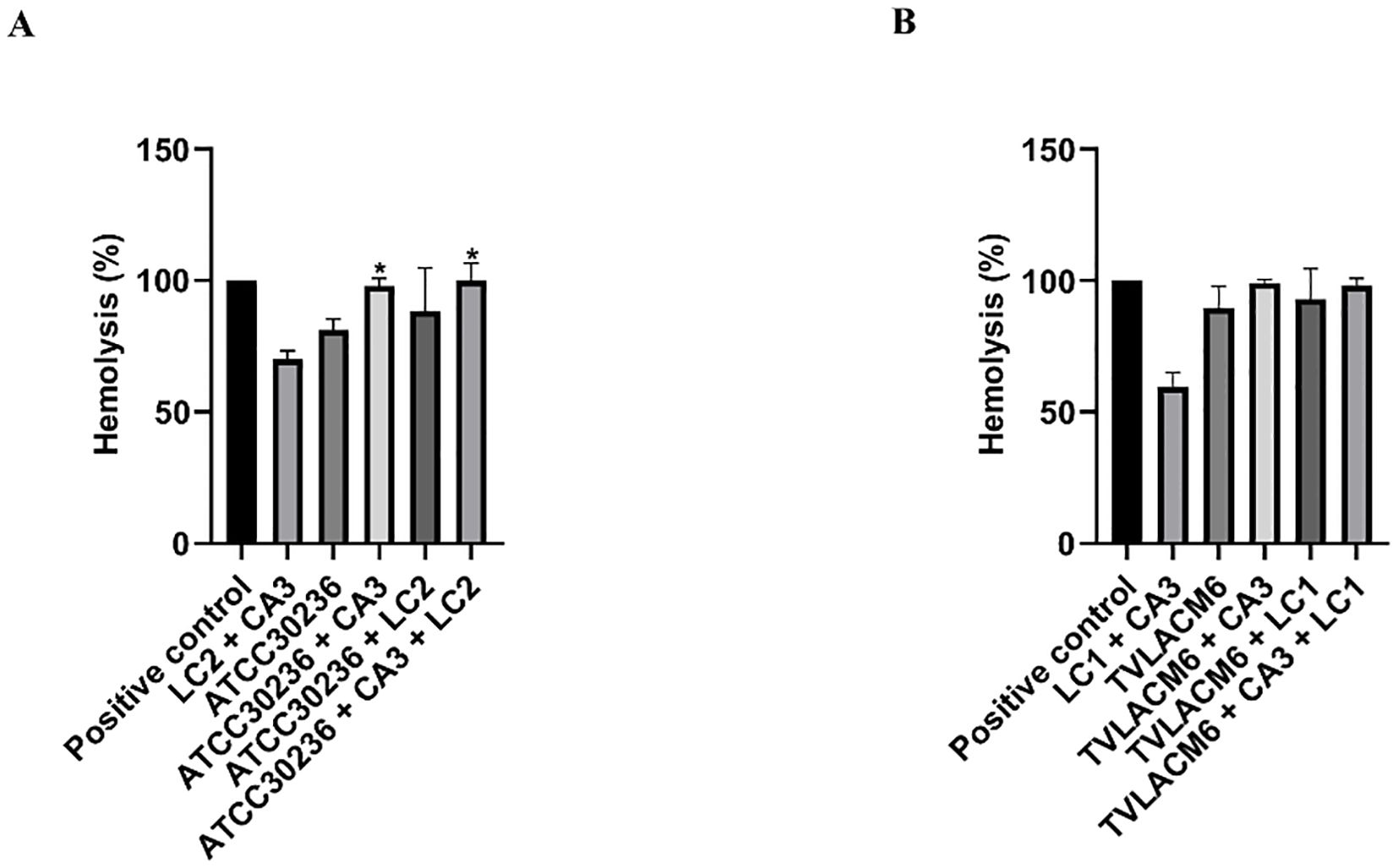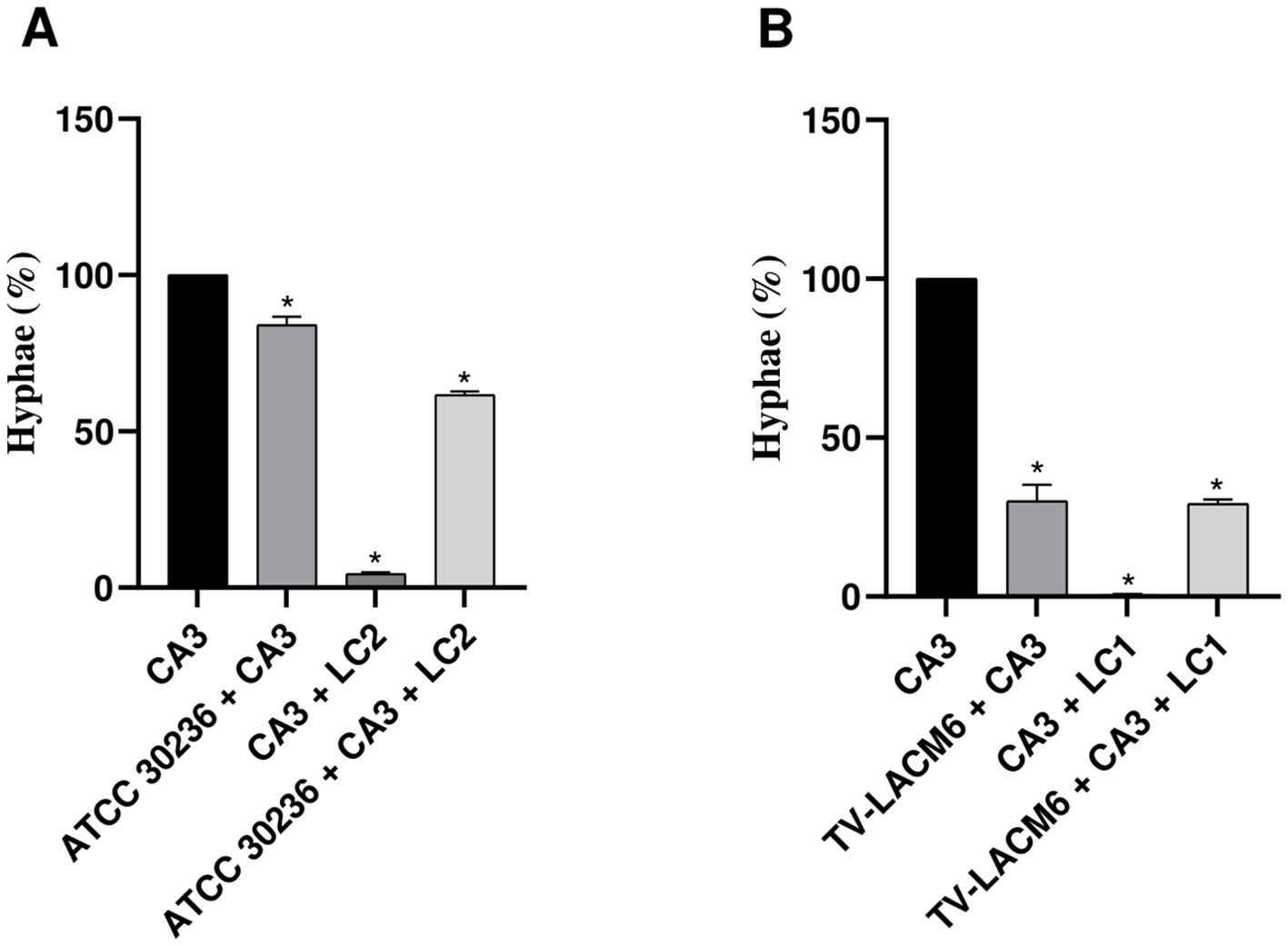- Faculdade de Farmácia and Centro de Biotecnologia, Universidade Federal do Rio Grande do Sul, Porto Alegre, RS, Brazil
By Cardoso FG, Santos LTd, Menezes SA, Rigo GV and Tasca T (2025). Front. Parasitol. 4:1523113. doi: 10.3389/fpara.2025.1523113
In the published article, there was a mistake in Figure 3 and Figure 5. Figure 3 appeared in place of Figure 5 and vice versa. The corrected figures appear below.

Figure 3. Hemolysis of erythrocytes co-incubated with monocultures or co-cultures of Trichomonas vaginalis, Candida albicans and Lactobacillus crispatus. (A) ATCC30236 T. vaginalis standard isolate, C. albicans (CA3), and L. crispatus (LC2). (B) TV-LACM6 T. vaginalis fresh clinical isolate, C. albicans (CA3), and L. crispatus (LC1). Positive control of hemolysis is erythrocytes treated with 0.2% Triton X-100. Results are expressed as a percentage of total hemolysis, presented as the mean ± S.D. of at least two blood samples. The percentage of hemolysis from erythrocytes co-incubated with T. vaginalis monocultures was compared to co-cultures with the protozoan. (*) indicates a significant difference.

Figure 5. Yeast-to-hyphal form transition of Candida albicans in monoculture and co-culture. (A) Co-culture of C. albicans (CA3, initial density at 3.33x104 CFU/mL) with ATCC Trichomonas vaginalis isolate (ATCC3026, initial density at 1 x 106 trophozoites/mL) and second density of Lactobacillus crispatus (LC2, initial density at 5.53x106 CFU/mL). (B) Co-culture of CA3 with fresh clinical T. vaginalis isolate (TV-LACM6, initial density at 1 x 106 trophozoites/mL) and first density of L. crispatus (LC1, initial density at 5.53x107 CFU/mL. The date were expressed by percentage de hyphae formation. Results are representative of two independent experiments conducted with triplicate assays. (*) Statistically significant difference (p < 0.05).
The original article has been updated.
Publisher’s note
All claims expressed in this article are solely those of the authors and do not necessarily represent those of their affiliated organizations, or those of the publisher, the editors and the reviewers. Any product that may be evaluated in this article, or claim that may be made by its manufacturer, is not guaranteed or endorsed by the publisher.
Keywords: Candida albicans, co-culture, Lactobacillus crispatus, Trichomonas vaginalis, vaginal microbiota, vaginitis
Citation: Cardoso FG, Santos LTd, Menezes SA, Rigo GV and Tasca T (2025) Correction: In vitro co-culture model of Trichomonas vaginalis, Candida albicans, and Lactobacillus crispatus: a system for assessing antimicrobial activity and microorganism interactions in vaginitis. Front. Parasitol. 4:1711595. doi: 10.3389/fpara.2025.1711595
Received: 23 September 2025; Accepted: 29 September 2025;
Published: 10 October 2025.
Approved by:
Frontiers Editorial Office, Frontiers Media SA, SwitzerlandCopyright © 2025 Cardoso, Santos, Menezes, Rigo and Tasca. This is an open-access article distributed under the terms of the Creative Commons Attribution License (CC BY). The use, distribution or reproduction in other forums is permitted, provided the original author(s) and the copyright owner(s) are credited and that the original publication in this journal is cited, in accordance with accepted academic practice. No use, distribution or reproduction is permitted which does not comply with these terms.
*Correspondence: Tiana Tasca, dGlhbmEudGFzY2FAdWZyZ3MuYnI=
 Fernanda Gomes Cardoso
Fernanda Gomes Cardoso Tiana Tasca
Tiana Tasca